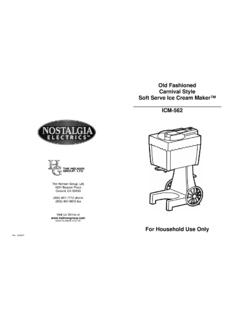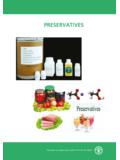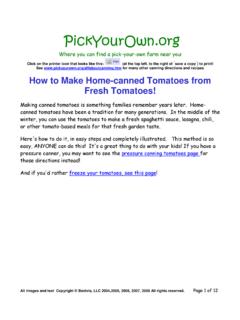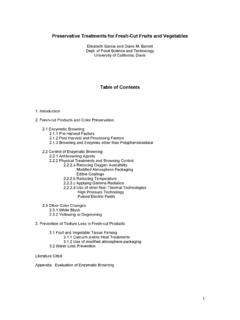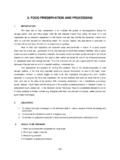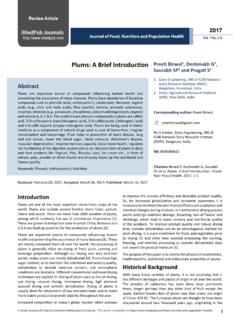Transcription of Making and Canning (or freezing) Homemade …
1 All images and text Copyright Benivia, LLC 2009 All rights reserved. Page 1 of 13 Where you can find a pick - your -own farm near you! Click on the printer icon that looks like this: (at the top left, to the right of save a copy ) to print! See for many other Canning directions and recipes Making and Canning (or freezing) Homemade Spaghetti Sauce from Fresh Tomatoes, with a water bath canner Making and Canning your own spaghetti sauce is something families remember years later. No store bought spaghetti sauce compares with the taste of that made from your own tomatoes from your garden or fresh-picked from a local farm! In the middle of the winter, you can make a meal with your spaghetti sauce and taste the summer flavor of fresh tomatoes. This recipe is for spaghetti sauce WITHOUT meat, so you can use a water bath canner or a pressure canner.
2 The USDA does not have a recipe for spaghetti sauce for a water bath canner (they only have one for a pressure canner, it's a bit different; if you have a pressure canner, you may want to see this page for spaghetti sauce using a pressure canner), but both the prepackage season mixes (like Ball's, Mrs. Wages) and the Ball Blue book do have a water bath canner version. The Homemade version (Ball), which they call "seasoned tomato sauce" requires the addition of lemon juice (not vinegar) to help acidify it. You can add meats, but that requires a pressure canner and a different set of directions (see this page for directions for spaghetti sauce with meat) And if you only want to make 1 quart of spaghetti sauce, see this page instead. Here's how to do it, in easy steps and completely illustrated.
3 This method is so easy, ANYONE can do this! It's a great thing to do with your kids! I've added free labels for your jars here, in a Word format! Just download, edit, and print in label paper. All images and text Copyright Benivia, LLC 2009 All rights reserved. Page 2 of 13 Ingredients Yield: 7 pints Tomatoes - about 20 lbs (yes, you need a big basketful - you remove the skins, seeds and a lot of the water, so it takes a lot to start.) Spaghetti sauce mix or your own seasonings. The Mrs. Wages, Ball or Harvest spaghetti sauce mix sells for about $ to $ per packet. A packet will make about a 7 pint jars. See step 7 below for Making your own seasonings. Equipment 1 Water bath Canner (a huge pot to sterilize the jars after filling (about $30 to $35 - $30 at mall kitchen stores and local "big box" stores.))
4 Note: we sell many sizes and types of canners for all types of stoves and needs - see Canning supplies). Tomatoes are on the border between the high-acid fruits that can be preserved in a boiling-water bath and the low-acid fruits, vegetables and meats that need pressure Canning Pint Canning jars (Ball or Kerr jars can be found at Publix, Kroger, Safeway and local "big box" stores - about $8 per dozen jars including the lids and rings Pint size works best, but quarts are allowed, too, since the pressure canner will thoroughly heat them.! Lids - thin, flat, round metal lids with a gum binder that seals them against the top of the jar. They may only be used once. Rings - metal bands that secure the lids to the jars. They may be reused many times. Jar grabber (to pick up the hot jars) Lid lifter (has a magnet to pick the lids out of the boiling water where you sterilize them.)
5 ($2 at mall kitchen stores and local "big box" stores, but it's usually cheaper online from our affiliates) 1 large pot. Large spoons and ladles Jar funnel ($3-Grocery stores, like Publix, Kroger and Safeway and local "big box" stores; sometimes even hardware stores) All images and text Copyright Benivia, LLC 2009 All rights reserved. Page 3 of 13 Process - How to Make Spaghetti Sauce from Fresh Tomatoes Step 1 - Selecting the tomatoes It's fun to go pick your own and you can obviously get better quality tomatoes! At right is a picture of tomatoes from my garden - they are so much better than anything from the grocery store. And if you don't have enough, a pick -you-own farm is the pace to go! At right are 4 common varieties that will work: Top left: Beefsteak Top right: Lemon Boy, yellow Bottom left: Roma, paste-type Bottom right: Better Boy The picture at right shows the best variety of tomato to use: Roma; also called paste tomatoes.
6 They have fewer sides, thicker, meatier walls, and less water. And that means thicker sauce in less cooking time! Also, you don't want mushy, bruised or rotten tomatoes! All images and text Copyright Benivia, LLC 2009 All rights reserved. Page 4 of 13 Step 2 - Removing the tomato skins Here's a trick you may not know: put the tomatoes, a few at a time in a large pot of boiling water for no more than 1 minute (30 - 45 seconds is usually enough) Plunge them into a waiting bowl of ice water. This makes the skins slide right off of the tomatoes! If you leave the skins in, they become tough and chewy in the sauce, not very pleasant. Step 3 - Removing seeds and water After you have peeled the skins off the tomatoes, cut the tomatoes in half.
7 Now we need to remove the seeds and excess water. All images and text Copyright Benivia, LLC 2009 All rights reserved. Page 5 of 13 Step 4 - Squeeze of the seeds and water Just like it sounds: wash your hands then squeeze each tomato and use your finger or a spoon to scoop and shake out most of the seeds. You don't need to get fanatical about it; removing just most will do. Step 5 - Drain the tomatoes Toss the squeezed (Squozen? :) tomatoes into a colander or drainer, while you work on others. This helps more of the water to drain off. You may want to save the liquid: if you then pass it through a sieve, screen or cheesecloth, you have fresh tomato juice; great to drink cold or use in cooking! By draining the water off now, you'll end up with a thicker spaghetti sauce in less cooking time!
8 And that preserves vitamins (and your sanity). FYI, the 20 pounds of raw, fresh, whole tomatoes you started with should produce about 7 - 9 pints of "squeezed" tomatoes Step 6 - Get the jars and lids sterilizing The dishwasher is fine for the jars; especially if it has a "sterilize" cycle. I get that going while I'm preparing everything else, so it's done by the time I'm ready to fill the jars. Be sure to let it go through the rinse cycle to get rid of any soap! Lids: Put the lids into a pan of boiling water for at least several minutes. All images and text Copyright Benivia, LLC 2009 All rights reserved. Page 6 of 13 Note: everything gets sterilized in the water bath (step 7) anyway, so this just helps to ensure there is no spoilage later!) Step 7. Mix or your own seasoning?
9 Either works equally well. The spaghetti sauce mix (see the box below) for Canning has the advantage of being tested and VERY easy to use. It's basically a type of corn starch, onion powder, salt and seasoning. It doesn't have any preservative to improve the Canning , so the advantage is just that it is easier and safe. Remember, this recipe is for NO meat! (see this page for directions for spaghetti sauce with meat) Otherwise, this slightly modified version of the Ball Blue Book recipes works well: 2 cups chopped fresh onions (then saut or microwave them until they are soft) 3 Tablespoons of oregano 3 clove of garlic, minced 3 bay leaves 2 Tablespoons diced, fresh OR dried basil 1/4 teaspoon black pepper 2 tablespoons chopped celery (optional, may be too strong for some folk's tastes) 2 Tablespoons chopped red sweet peppers 2 teaspoon salt (optional - I don't put any in!)
10 1/4 cup lemon juice (helps to acidify it, not necessary if you have a pressure canner) 1/4 cup red wine (optional) I think a little burgundy makes it!) And if you like your spaghetti sauce thick, add either tomato paste - 1 or 2 small cans should do it, A note about spices: Less spice, especially garlic and onions in canned sauce is better. They tend to strengthen and sometimes become bitter in storage. So use less when you prepare the sauce and add more when you actually use it, if you want! Step 8 - Combine and bring the sauce to a gentle simmer Combine the tomatoes and spices together in a big pot. There's generally no need to add liquid, most types of tomatoes have so much water, we will need to boil it down to drive off much of the water to thicken the sauce.




